The colour that means both life and death
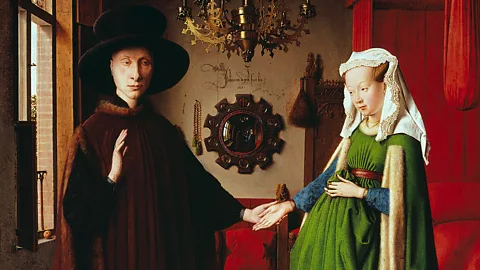 Getty Images
Getty ImagesGreen has symbolised both decay and regeneration, offering a bridge between this world and the next, writes Kelly Grovier.
Beware of green. It can’t be trusted. Leonardo da Vinci knew, and cautioned his contemporaries against the pigment’s toxic instability. Its beauty, Leonardo warned, “vanishes into thin air”. Volatile and evanescent, green is more than just a colour. It is the energy that connects us to the unknown. Remove green from the palette of art history and a bridge between life and death would disappear. Equal parts morbid and vital, green curdles the cadaverous cheeks of Pablo Picasso’s macabre portrait of his young friend, Carlos Casagemas, who shot himself dead in lovelorn torment at the age of 20, while at the same time ignites with joyous chlorophyllic fire the life-affirming and ever-verdant canvases of Claude Monet.
More like this:
To dabble in green is not merely to tread a path between being and unbeing, but to make inroads into the mysteries of each. Simultaneously the colour of putrefaction and of verdurous regeneration, green participates with unbiased vividity in decay and rebirth. Perhaps it is green’s teasing ambiguity that compelled Leonardo himself, against his own better counsel, to clad his most famous and enigmatic subject, the Mona Lisa, in a darkening shade of that colour – one that has since bruised itself to a sublime and submarine blackness in the subconscious of cultural history.
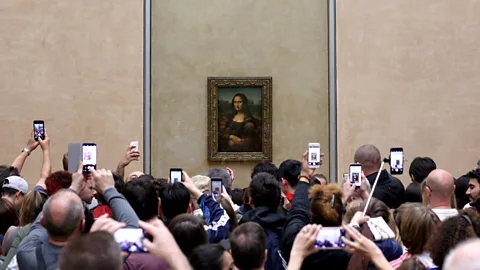 Getty Images
Getty ImagesDonning the deepest of shadowy green costumes, La Gioconda night-swims in the vitrine of our psyche and has long been recognised as a mystical commuter between the world of the living and that of the dead. “Like the vampire,” the 19th-Century English essayist Walter Pater once wrote of her, “she has been dead many times and learned the secrets of the grave”. Describing Leonardo’s inscrutable sitter as “older than the rocks among which she sits”, Pater proceeds to imagine that Mona Lisa has, throughout history, returned again and again as everything from “a diver in deep seas” to a savvy operator who has woven “strange webs with Eastern merchants”. Ceaselessly resurgent in her murky green gown, which symbolised her status as a merchant’s wife, Mona, according to Pater, was “the mother of Helen of Troy” and the “mother Mary”.
Long before Leonardo reached for green, the colour had been assigned a special esoteric place in cultural imagination. Ancient Egyptians reserved green for the bold beryl complexion of their god of life and death, Osiris – ruler of the underworld, who held dominion over the passage of souls between this world and the next. Typical depictions of Osiris, such as one found on the 13th-Century BC walls of the burial tomb of Horemheb, the last monarch of the 18th dynasty of Egypt, portray a skinny, grassy-skinned god, whose false pharaoh’s beard marks him out as a deity of incontestable pre-eminence.
 Getty Images
Getty ImagesPerennially young, Osiris was believed to be a serial resuscitator, both of himself and of the natural world. Holding sway over the flow of floods and flourishing of flora alike, leafy-cheeked Osiris, it was believed, would eventually show the souls of Egypt’s kings the path to resurrection.
Flora and fauna
For millennia, concocting green pigments was achieved by a variety of artistic alchemies that harnessed the hues of everything from pulverised malachite to the juice of buckthorn berries, from dessicated foxgloves and fraxinus leaves, to soaking yellow saffron in the purple dye of woad, also known as the ‘The Asp of Jerusalem’. Verdigris, among the more common iterations of the colour, and the one of which Leonardo was most wary, is forged in a curious ritual that involves the slow sousing in wine of a brass or copper blade.
An acetic crust of green that scabs to the metallic surface is then scraped clean and ground into pigment. It was a green ghost of similar chemical contrivance that confirmed to scientists digging recently for the remains of the 16th-Century Danish astronomer Tycho Brahe that they had indeed found their target. Known to have worn a prosthetic nose to replace the one he’d lost in a sword fight in 1566, Brahe’s aesthetic skull bore traces of copper and zinc when, like a disciple of Osiris, it eventually came up for air in 2012.
Fertile with life, even in death, the invocation of green in countless masterpieces from antiquity to the present day impregnates our eye with expectancy. Everything about the physique, posture and gestures of Giovanni di Nicolao Arnolfini’s green-enrobed wife, who seems to rest her tired hand tenderly on her tummy’s bump in Jan van Eyck’s famous painting, The Arnolfini Portrait (painted in 1434), leads our modern mind to suspect that she is pregnant, however convinced art historians may be that she isn’t. The great gush of cascading green that capsizes our eye, scholars contend, is more likely a symbol of hope for the eventual blessing of children. Green springs eternal.
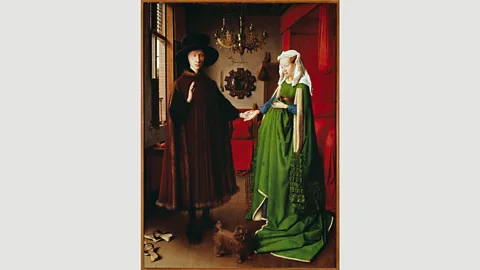 Getty Images
Getty ImagesAn alternative reading of the riddling portrait only amplifies the eeriness of green’s potential to wed the living and the dead. According to one theory, the depiction of the woman in Van Eyck’s work is herself a composite double-portrait of two successive wives of Giovanni di Nicolao – his first having died in childbirth. Supporters of this view point to tropes of death that haunt the painting, such as the extinguished wick on the candle above her. Certainly the complex convex mirror, bolted to the back of the painting, which warps the couple’s reflection as if into a different continuum of reality, compounds the sense of strangely splitting selves that reverberate from the painting. If ever there was a colour capable of cloaking such a curious compression of life and death, it’s green.
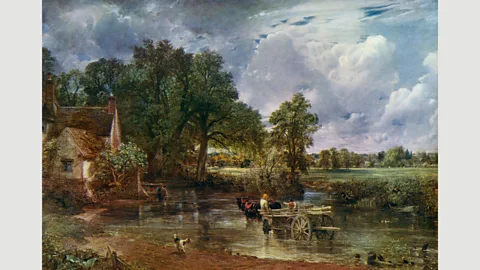 Getty Images
Getty ImagesSo green goes, sowing into the story of art the mysteries of our own fleeting appearance in the world. The murky green water that laps against the ochre edge of the River Stour in John Constable’s famous Romantic landscape The Hay Wain, delineates a boundary between the world that the artist can see in the here-and-now and one that haunts his imagination from childhood. Look closer at the weave of summer greenness at which the little dog in the foreground appears to pant, and you can barely discern the ghost of a horseman and barrel that the artist had once intended to include in the painting – a spectre that, over time, is re-sculpting itself from the verdurous summer air that Constable has mystically conjured.
Though rightly celebrated for the accuracy of his carefully observed clouds, Constable is a master too of earthy hues and terrestrial textures. The tapestry of greens he weaves in The Hay Wain is a tour de force of that colour’s ability to convey the vibrancy of nostalgia for a place that ceaselessly shifts in one’s memory between wilting loss and luminous revelation.
Hiding in plain sight
In more recent eras of artistic expression, green has continued to be an enigmatic hue that hides as much as it reveals. Paul Gauguin’s seminal symbolist painting Green Christ (1889) is a teasing tangle of the colour’s contradictory connotations. Over a stone statue of the deceased Christ in the middle distance of the painting, a lucent layer of moss has stitched itself like a second skin. The face of a Breton woman, who stands in the shadow of that sculpture, is tinged a sepulchral green, as if she were slowly turning into the life-in-death and death-in-life statue – as if a kind of chromatic continuum exists between the physical world she inhabits and a mystical one that lies beyond.
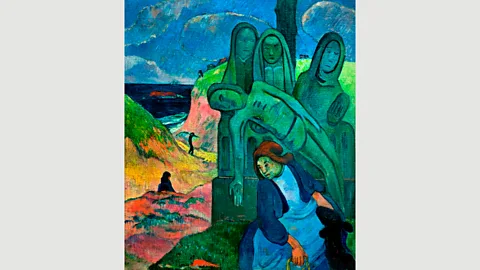 Alamy
AlamyBelgian surrealist painter René Magritte’s famous anti-self-portrait, The Son of Man (1964), defies the logic of likenesses by refusing to let the viewer see the key features of the artist’s face by interposing between them and us the greenest of green apples the mind is capable of picturing. “Everything we see hides another thing, we always want to see what is hidden by what we see,” Magritte observed to an interviewer. “There is an interest in that which is hidden and which the visible does not show us. This interest can take the form of quite an intense feeling, a sort of conflict one might say, between the visible that is hidden and the visible that is present.”
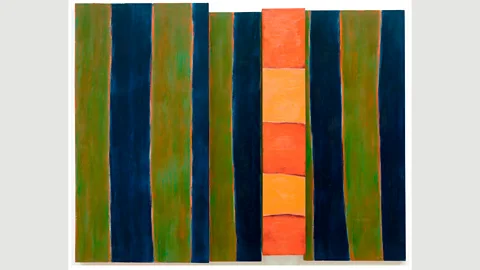 Sean Scully and Blain Southern
Sean Scully and Blain SouthernNo contemporary artist has understood more profoundly the rhythms of the visible that is not there and the visible that is, than the Irish-American abstract painter Sean Scully. The bold vertical columns of Scully’s The Bather (1983), inspired by Henri Matisse’s Bathers by a River, painted 70 years earlier, are stripped-down stand-ins for the already over-stylised bodies Scully recalls from Matisse’s work. Intensified by the boxy protrusions that complicate the carpentry of Scully’s work, which physically intrudes into the gallery-goer’s space, the ficus greens of Scully’s torso-wide trunks have succeeded in achieving an effect to which centuries of artists have only aspired: converting green from perishable colour into purest feeling.
If you would like to comment on this story or anything else you have seen on BBC Culture, head over to our Facebook page or message us on Twitter.
And if you liked this story, sign up for the weekly bbc.com features newsletter, called “If You Only Read 6 Things This Week”. A handpicked selection of stories from BBC Future, Earth, Culture, Capital and Travel, delivered to your inbox every Friday.
